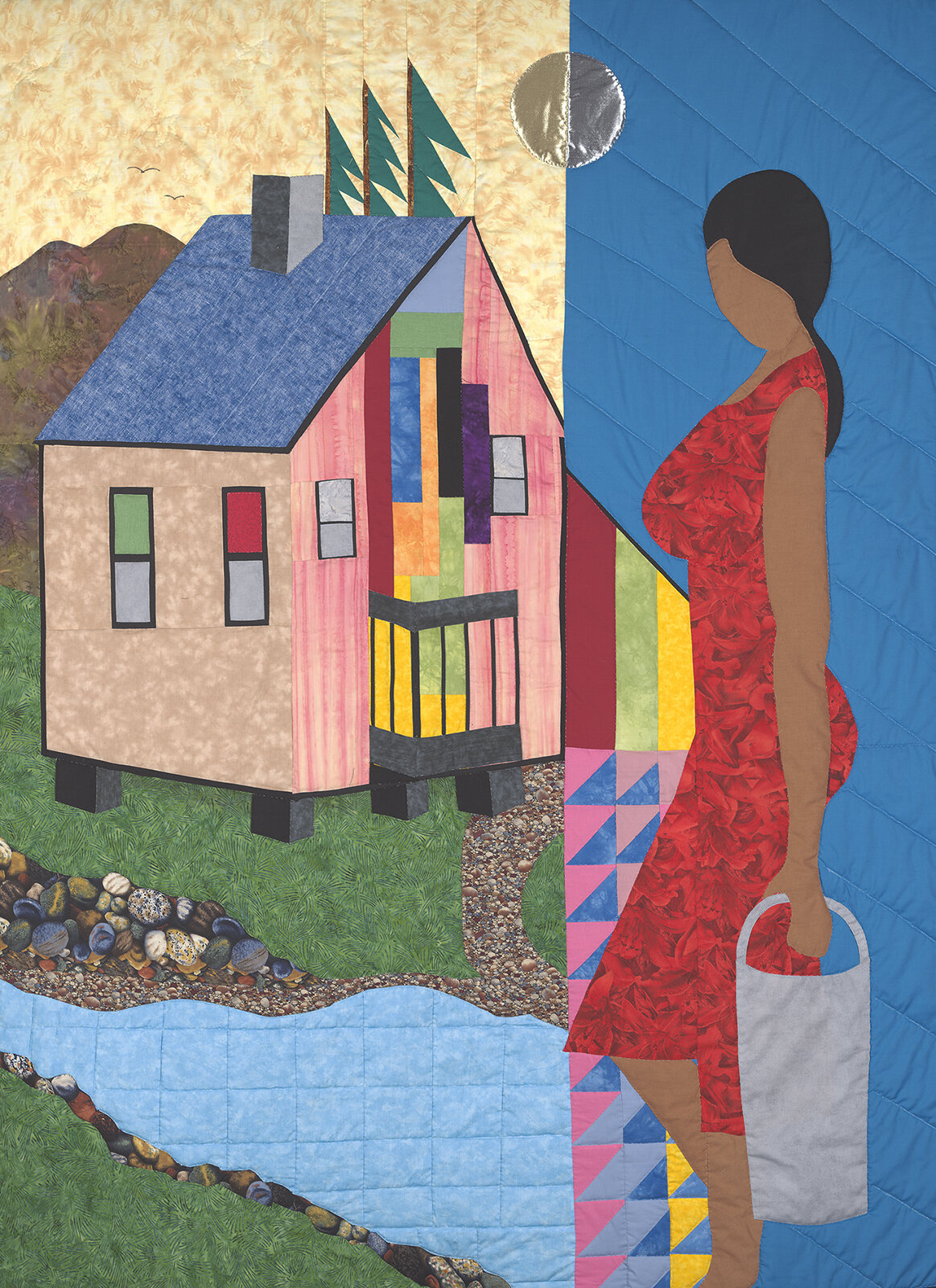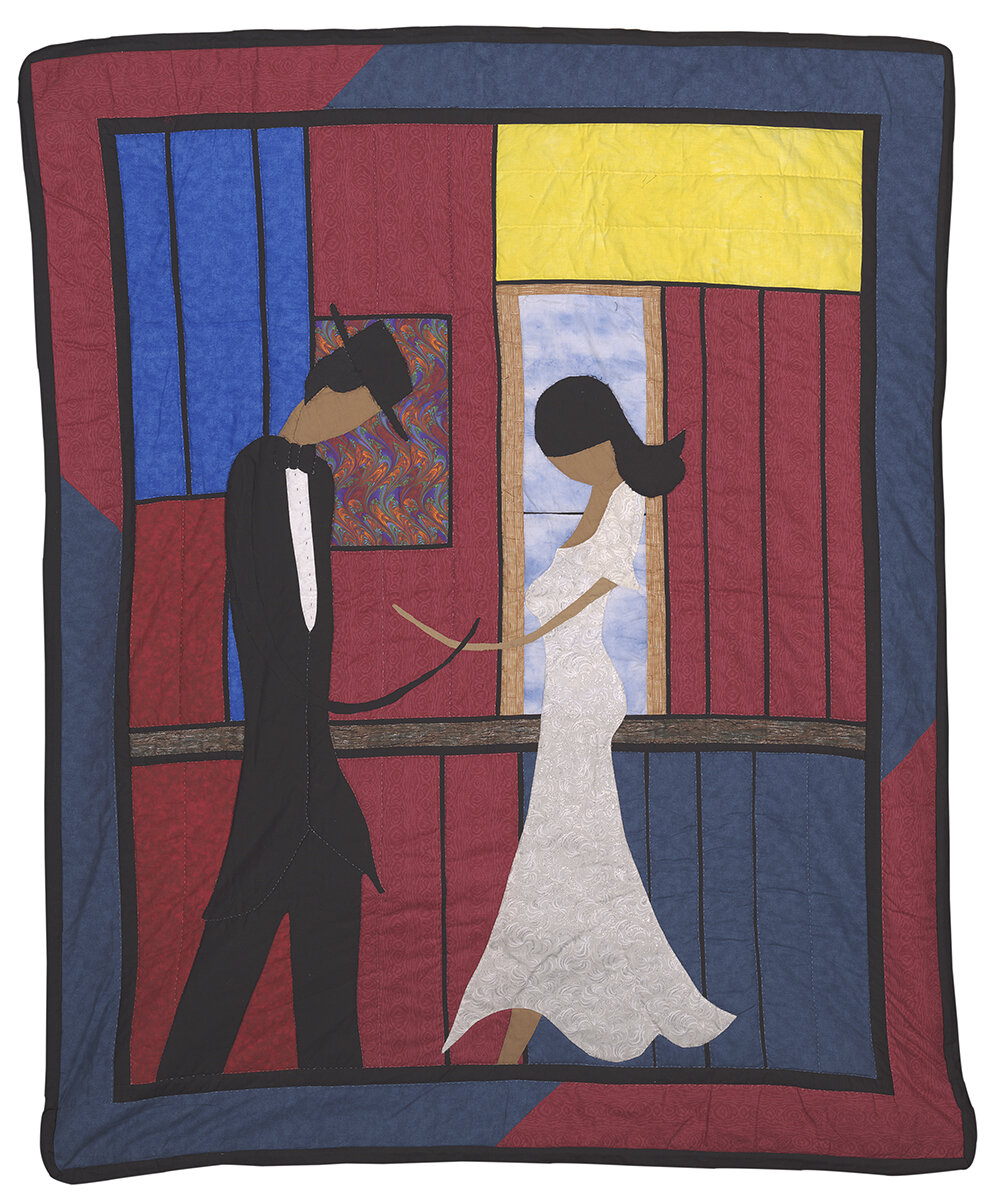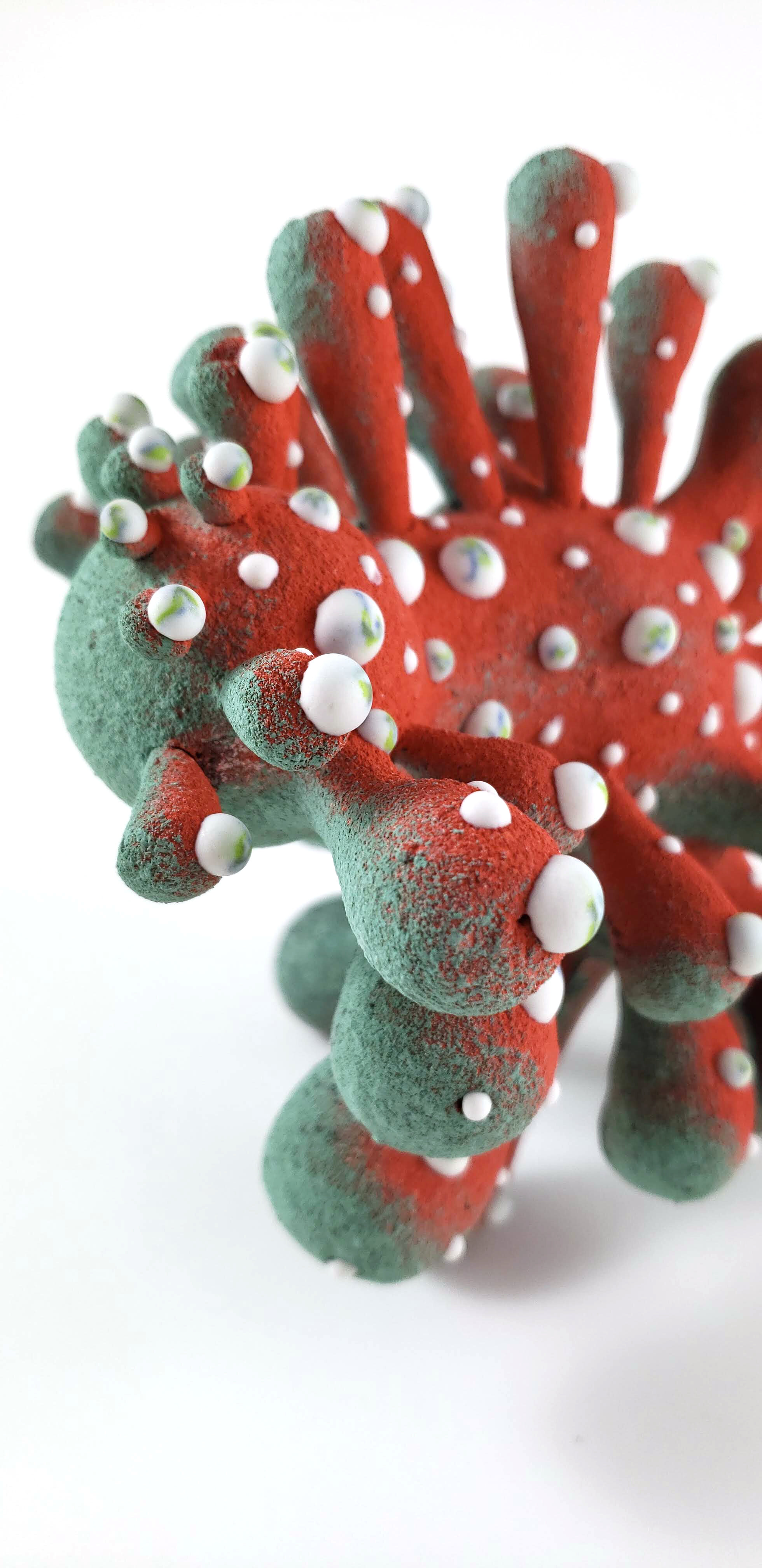Secret Codes
Heather Cromwell (quilt top) and Mary MacLean (quilt), Betty Hartley #1, 2012. Pieced, appliquéd and hand stitched, 175 x 221 cm. PHOTO COURTESY OF THE BLACK ARTISTS NETWORK OF NOVA SCOTIA
African Nova Scotian quilts have a rich history and tradition, and a particular place in African-American quiltmaking practices. Curator and artist David Woods works with traditional quiltmakers to document, preserve and re-animate this fascinating practice.
Betty Hartley is going to the well to get water for the evening’s dinner dishes. In preparation, she has smoothed down her black hair and put on a red dress that clings to her curves. Slipping from the back porch, she sashays in the direction of the woods, her hips and the bucket clasped in one hand swinging. The moon is full and bright, lighting her way — and her hourglass figure.
She glances coyly over her shoulder to see if someone is watching. Betty does appreciate an audience.
“She may only be going to the well for water, but she is looking fine,” says quiltmaker Heather Cromwell with a laugh. “It’s as if she’s thinking, ‘I have to look my best. Someone might see me.’ ”
The quilt, “Betty Hartley #1,” is part of the exhibition The Secret Codes: Contemporary African Nova Scotian Narrative and Picture Quilts, a collaboration between the Vale Quilters Association of New Glasgow (and others) and artist David Woods of Dartmouth. First organized in 2012 to coincide with the national Quilt Canada conference in Halifax, N.S., there have been a few iterations of the exhibition since then. And now there are aspirations for an ambitious national tour, which would kick off at the Confederation Centre of the Arts in Charlottetown, P.E.I., in the spring of 2021.
Conceived by Woods, a poet, playwright, artist and curator, the exhibition comprises a few parts, including selections of historic and contemporary quilts by Black makers. Another part will focus on “Underground Railroad quilts”: sampler quilts of traditional quilt block designs — monkey wrench, north star, flying geese, bear’s paw and more — believed to guide escaped slaves from southern plantations to freedom in the north. But the heart of the exhibition will be the narrative and picture quilts based on Woods’ original sketches of village life and brought to life by the women of the Vale Quilters, named after the road in New Glasgow, where Nova Scotians of African descent first settled more than 200 years ago.
The history of Black Nova Scotians reaches back to the early founding years of the province. Black communities can trace their origins going back centuries, when Nova Scotia held the promise of a better life for immigrants of African descent. Many Black Nova Scotians are descended from Black Loyalists who came as refugees during the American Revolution or the Black slaves who accompanied white Loyalists at the same time. Others are descended from Jamaican Maroons who built the fortifications on Citadel Hill in Halifax or later Black refugees, who escaped slavery in the southern states through the Underground Railroad.
Cromwell, whose ancestors were Black Loyalists, has been quilting for 25 years or so. Her first quilt was a brick quilt, a very basic pattern of rectangles sewn together in rows. After a few years working on her own, she joined the Northumberland Quilt Guild in nearby Pictou, and was later invited to join the Vale Quilters. At the time, the small group of Black women was already working with Woods, and Cromwell was intimidated by how the women were able to interpret Woods’ postcard-size doodles into magnificent textile creations. The pieced and appliquéd narrative quilts they were making were much more sophisticated and complex than the simple quilts she made to keep her family warm at night. Nevertheless, she embraced the challenge.
“You know, it feels bigger than me. It’s exciting. It feels like I’m contributing something tangible to Black history,” says Cromwell, a mother and grandmother who works at Service Canada.
Heather Cromwell (quilt top) and Mary MacLean (quilt), The Dance, 2007. Pieced, appliquéd and hand stitched, 175 x 221 cm. PHOTO COURTESY OF THE BLACK ARTISTS NETWORK OF NOVA SCOTIA
The first quilt she attempted based on one of Wood’s drawings is called “The Dance.” A sharply dressed man and an elegant woman face each other shyly, heads bowed. They are about to step into each other’s arms, about to join the other couples already on the dance floor.
TOP Vale Quilters Ward 4 Community Ctr, New Glasgow annual show and workshop, 2012.
CENTRE David Woods speaking at the Opening of Mary Bendolph: Gees Bend Quilts and Beyond Exhibition, Art Gallery of NS, 2007.
BOTTOM Vale Quilters at the Museum of Industry Stellarton NS at the opening of “Our Ancestor’s Garden”, 2007.
“David came to us with some drawings and that’s the one I picked. I liked the way her dress flowed, and I chose a sparkly silver fabric for her dress. I imagined the dress floating around her legs as she danced.
“It’s like it is New Year’s Eve and these two have met at the dance. There are tons of people around, but really it’s just these two all by themselves in the whole wide world and they’re taking the dance floor by storm.”
Sitting across a table at a Tim Horton’s patio in Dartmouth, David Woods shrugs when asked what his quilt drawings are about. He’s a large man, solid, dressed in a black shirt and pants, with a shell necklace at his throat. He brings out a few of his drawings, anchoring them with his cellphone so they don’t blow away across the busy parking lot. They depict small, everyday scenes focusing on hearth and home from the not-too-distant past — women cooking, making baskets and carrying water — familiar to the folks who live in or are from Nova Scotia’s 52 historic Black communities. The life depicted is rural; the inclusion of a well is not unusual since basic services such as sewage and water arrived much later to Black neighborhoods.
Human figures are abstracted, Picasso-esque, sometimes faceless. Traditional quilt motifs, such as the log cabin block and the triangles known as flying geese, are incorporated into the backgrounds or used to border central images. The scenes are vibrantly coloured using pencil crayons.
“The sketches are not really conscious, but they seem to reflect kitchen culture. In rural communities, everything is centred around the kitchen.”
“I’m not trying to make it sound mysterious,” he continues. “I just draw. The best that I can say is that they’re improvised, they’re riffs.”
Just like his collaboration with the Vale Quilters: One thing led to another, which led to another, and eventually to a creative synergy manifested in quilts “which talked about being Black, quilts that are decidedly about the Black community.”
Woods knew Vale founding member Myla Borden since their university days at Dalhousie. She contributed a picture quilt to the large group exhibition In This Place at the Anna Leonowens Gallery, Nova Scotia College of Art and Design, in 1998. In gathering art for the groundbreaking show, the first exhibition of Black art in Nova Scotia, Woods travelled to Black communities far and wide looking for work he could include.
“When I went to North Preston, an elderly lady asked me if I was including quilts because that’s what the women did,” he recalled. “I had not considered quilts for the exhibition, not because of any deliberate animosity to quilts but I guess I was thinking of more traditional media — painting, prints, sculpture — but when she said that, I knew quilting was something to take seriously. And, as I kept looking, I had a revelation. Quilting was far more widespread than I imagined.
“There was a tremendous response to the show and to the presence of the quilts in the show.”
Following In This Place came When Black Women Usta Fly, the first exhibition of African Nova Scotia quilts, at the Dartmouth Heritage Museum in 2002. Both Woods and Borden were involved in that show too: Woods as curator, Borden as a contributor. Black quilters were starting to realize that they had an expression uniquely their own within the wider tradition of quilting in North America. They had a voice, rich and unique, and they were talking about being Black.
“It’s an attractive idea— that patterned quilts made by slaves and those sympathetic to them contained secret coded messages that helped fugitives navigate through danger and make their way to freedom.”
Myla Dorrington, A Visit from Mamay, 2012. Pieced, appliquéd and hand stitched, 239 x 216 cm. PHOTO COURTESY OF THE BLACK ARTISTS NETWORK OF NOVA SCOTIA
Around the same time, two other developments were happening to reinforce this idea. First, was the discovery of “Underground Railroad quilts,” a concept first raised in the book Hidden in Plain View (Anchor Press, 2000) by historian Jacqueline Tobin and art history professor Raymond Dobard. In the book, the authors posit that slaves made encoded quilts and used them to navigate their escape on the Underground Railroad.
It’s an attractive idea — that patterned quilts made by slaves and those sympathetic to them contained secret coded messages that helped fugitives navigate through danger and make their way to freedom. Hung on a clothesline, the bear’s paw quilt, for example, could mean make your way north through the Appalachians. The appearance of a tumbling block quilt was an indication that the time to go was imminent.
While the idea of Underground Railroad quilts immediately captured the public imagination, it was also met with skepticism. More folklore than fact, say some. Where’s the evidence? demand others.
But Woods counters: “Why not?”
“People tend to dismiss all these things, but Blacks in those days operated in code. They had to,” says Woods, pointing out that Negro spirituals allowed field slaves to communicate hidden messages right under the noses of overseers.
Cromwell likes that old beloved patterns such as Drunkard’s Path and Wagon Wheel could have double meanings. In fact, she decided to make her own Underground Railroad sampler quilt, bringing the symbols together and reflecting on their possible meanings.
The quilt is special for another reason too. Cromwell’s granddaughter, Taylor, now 18, sewed the quilt with her, her mother Mary did the hand quilting and son Rob made the label for it. Cromwell named her sampler “It Takes Four” for the contributions of four generations in its creation.
Second, was the art world’s notice of isolated Gee’s Bend, Ala., and the bold, improvised quilt creations made by the Black women there. In 1998, art collector William Arnett paid big money for a quilt that one Gee’s Bend resident had stitched together from worn-out work clothes and draped over a woodpile. Soon after, The Quilts of Gee’s Bend became a sensation when it made the rounds of New York; Washington, D.C.; Cleveland; Boston; Atlanta and San Francisco. The quilts, declared art reviewer Michael Kimmelman in The New York Times, are “the most miraculous works of modern art America has produced.”[1]
At the time the Gee’s Bend phenomena hit, Woods was Associate Curator at the Art Gallery of Nova Scotia and working to bring the exhibition to Halifax. He wasn’t able to land the big show, but he did arrange for another Gee’s Bend exhibition to come east for its only Canadian stop — Mary Lee Bendolph: Gee’s Bend and Beyond, which ran from April to September in 2007. Reinforcing the Black community’s interest in quiltmaking, Woods met with Nova Scotian Black quilters to suggest doing shows in their communities — North Preston, Weymouth, Shelburne, and New Glasgow — to coincide with the visit by Mary Lee Bendolph and other Alabama quilters to Nova Scotia. And that’s exactly what happened.
“It was a real landmark moment for quiltmakers in Nova Scotia,” says Woods. “I was encouraging quilters to create new works for shows, and they were looking to me for advice.”
“A little later, Myla asked me to create quilt designs for the Vale Quilters, but I really didn’t want to add this task to my burdened plate of projects at the time,” he admits. “I remember leaving the meeting in New Glasgow, pulling up to an all-night Tim Horton’s in nearby Stellarton and completing 60 to 70 quilt doodles that very night. That’s the genesis of The Secret Codes.”
The stunning quilt “The Ecstasy of Amelda Colley” is one of the signature images from the first show in 2012, staged at the Public Archives of Nova Scotia’s Chase Gallery as hundreds of quilters from across the country congregated in Halifax for Quilt Canada.
Made by Borden to Woods’s design, the quilt is of a young girl: her head tipped back, lips open in song, arms stretched across the full width of the quilt. Her blackness stands out vividly from the background: there are red, yellow and blue patches of triangles, criss-crosses, waves and flames. This girl. She is young and full of joy. This girl is on fire.
Myla Borden, Ecstasy of Amelda Colley, 2007. Pieced and appliquéd, 213 x 170 cm. PHOTO COURTESY OF THE BLACK ARTISTS NETWORK OF NOVA SCOTIA
“I said to David, ‘Leave it with me.’ So, he drew it and I changed it. He would critique it, offer suggestions.‘Too much of this colour, not enough of this,’ ” says Borden, who confesses to a love of red. “He’s critical, but it’s not in a bad way. Whatever advice he had, I listened but I went my own way.”
“There’s a certain point when I work on a quilt and the people come alive for me. Like this girl. She makes me so happy,” Borden adds.
According to Woods, the older women of the group want an image they can follow exactly. The colours that Woods chooses in the original sketch are the colours of the finished quilt. “But Myla,” he adds, “she doesn’t need much. She just needs the image and she’s off and flying.”
Borden is equally complimentary of Woods. “He dreams so big. It’s crazy getting there, but once you do, it’s amazing. The man is a genius.”
The Vale Quilters meet monthly at each other’s houses, although meetings have been suspended since the onset of the pandemic in March. Meetings are more social than for working on projects — there’s usually a show and tell, lunch and time for “shooting the breeze,” says Borden. Besides Heather Cromwell and Myla Borden, members include Myla’s mother Marlene Dorrington, her aunt Frances Dorrington, as well as Shirley MacKenzie and Deb Jordan. One of their members, Marilyn Colleen Brannan, recently passed away.
The women are excited about the upcoming national tour. Cromwell, who has taken up the fiddle, has been asking Woods for a musical sketch. And Borden, a resource teacher, experienced a creative outburst during the pandemic that included finishing eight quilt tops, including one of Woods’ designs called “The Couple” of a man and a woman in church listening to the minister gesturing from the pulpit.
As for Woods, he’s thinking of taking one of his designs right through to a finished quilt, even dyeing the fabrics to get the colours he wants. He’s just not sure how to incorporate his need to improvise, and, after all, is already happy with what his collaborators come up with. “Wow, I’m always so overwhelmed.”
[1] Michael Kimmelman, “Jazzy Geometry, Cool Quilters,” New York Times, Nov. 29, 2002, https://www.nytimes.com/2002/11/29/arts/art-review-jazzy-geometry-cool-quilters.html.
This article was published in the Fall/Winter 2020 issue of Studio Magazine











